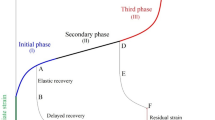Abstract
The objective of this paper was to develop a comprehensive evaluation method and index to evaluate the performance of sealants and fillers for cracks in asphalt concrete pavements using the method of principal component analysis. The performance experiments including cone penetration, softening point, flow, resilience and tension at low temperature respectively were conducted by reference of ASTM D5329 for eight sealants and fillers often used in China. There by a principal component model was developed and weight of every index was calculated. The experimental results show that there are significantly different performances for sealants and fillers often used in China. Principal component analysis is an objective method that evaluates and selects the performance of sealants and fillers for cracks in asphalt concrete pavements.
Similar content being viewed by others
References
Hou Y, Wang LB, Yue P T, et al. Modeling Mode I Cracking Failure in Asphalt Binder by Using Nonconserved Phase-field Model[J]. Journal of Materials in Civil Engineering, 2014, 26(4): 684–691
Hu J, Qian Z, Chen L. Fracture Behavior of Epoxy Asphalt Pavement on Steel Bridges based on Optical Fiber Sensing Technology and Numerical Simulation[J]. Journal of Wuhan University of Technology-Materials Science Edition, 2014, 29(4): 858 -862
Tarefder R, Ahmad M. Evaluating the Relationship Between Permeability and Moisture Damage of Asphalt Concrete Pavements[J]. Journal of Materials in Civil Engineering, 2014, 04014172
Masson JF, Collins P, Bundalo-Perc S, et al. Variations in Composition and Rheology of Bituminous Crack Sealants for Pavement Maintenance[J]. Transportation Research Record, 2005, 1933: 107–112
Li F, Li TG, Shi XP. Evaluation on High-temperature Adhesion Performance of Hot-applied Sealant for Asphalt Pavement[J]. Journal of Wuhan University of Technology-Materials Science Edition, 2014, 29(6): 1237 -1241
Hajj EY, Loria LG, Sebaaly PE, et al. Effective Timing for Two Sequential Aapplications of Slurry Seal on Asphalt Pavement[J]. Journal of Transportation Engineering, 2013, 139(5): 476–484
Li F, Huang SC, Xu J, et al. Research on Testing Methods for Low Temperature Performance of Sealants and Fillers for Cracks in Asphalt Pavements[J]. Journal of Highway and Transportation Reseach and Development, 2008, 25(9): 95–98
Sun HD, Fan WY, Shi JT, et al. Study on Adhesive Property of SACsealant for Cracks in Asphalt Pavement[J]. Journal of China University of Petroleum (Edition of Natural Science), 2016, 40(5): 159–165
Tan YQ, Guo M, Cao LP, Zhang L. Performance Optimization of Composite Modified Asphalt Sealant Based on Rheological Behavior[J]. Construction and Building Materials, 2013, 47: 799–805
Hasan O, Pranshoo S, Seyed SY, et al. Field Validation of Laboratory-Predicted Low-Temperature Performance of Hot-Poured Crack Sealants[J]. Transportation Research Record, 2014, 2431(1): 57–66
Li F, Huang SC, Xu J, et al. Performance Evaluation and Technical Requirement of Sealant and Filler in Asphalt Pavement[J]. Journal of Traffic and Transportation Engineering, 2009, 9(2): 7–11
ASTM D5329–04, Standard Test Methods for Sealants and Fillers, Hot-applied, for Joints and Cracks in Asphaltic and Portland Cement Concrete Pavements [S].
Li B, Han S, Xu OM, et al. Evaluation of Asphalt Pavement Performance based on Principal Component Analysis[J]. Journal of Chang'an University -Natural Science Edition, 2009, 29(3): 15–18
Chen J, Liu L, Zhou Z, et al. Optimization of Mining Methods based on Combination of Principal Component Analysis and Neural Networks[J]. Journal of Central South University-Science and Technology, 2010, 41(5): 1965–1972
Zhang YJ, Gregory M, Wang ML. Estimation of Pavement Macrotexture by Principal Component Analysis of Acoustic Measurements[J]. Journal of Transportation Engineering, 2014, 140(2): 04013004
Bianchini A. Pavement Maintenance Planning at the Network Level with Principal Component Analysis[J]. Journal of Infrastructure Systems, 2014, 20(2): 04013013
Palau C, Arregui F, Carlos M. Burst Detection in Water Networks using Principal Component Analysis[J]. Journal of Water Resources Planning and Management, 2012, 138(1): 47–54
Liu J, Cheng W, Zhang T. Principal Factor Analysis for Forecasting Diurnal Water-Demand Pattern Using Combined Rough-Set and Fuzzy-Clustering Technique[J]. Journal of Water Resources Planning and Management, 2013, 139(1): 23–33
Author information
Authors and Affiliations
Corresponding author
Additional information
Funded by the National Natural Science Foundation of China (Nos. 51408287 and 51668038), the Rolls Supported by Program for Changjiang Scholars and Innovative Research Team in University(IRT_15R29), the Distinguished Young Scholars Fund of Gansu Province(1606RJDA318), the Natural Science Foundation of Gansu Province (1506RJZA064), and the Excellent Program of Lanzhou Jiaotong University(201606)
Rights and permissions
About this article
Cite this article
Li, B., Ren, X., Li, Y. et al. Evaluation and selection of sealants and fillers using principal component analysis for cracks in asphalt concrete pavements. J. Wuhan Univ. Technol.-Mat. Sci. Edit. 32, 408–412 (2017). https://doi.org/10.1007/s11595-017-1611-0
Received:
Accepted:
Published:
Issue Date:
DOI: https://doi.org/10.1007/s11595-017-1611-0




